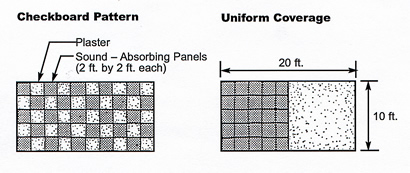| Return to www.asiproaudio.com | Print Page |
ACOUSTICAL MATERIAL DISTRIBUTION AREA EFFECT FOR SPACED SOUND ABSORBERS |
|
The efficiency of a sound-absorbing material can be affected by its distribution and location in a room. For example, 25 panels of sound-absorbing material, each 2 ft by 2 ft, will absorb more sound energy per panel when spaced in a "checkerboard" pattern on a 200 sq ft plaster ceiling than a uniform coverage of the same material. This increase in efficiency (called the area effect) is due to the diffraction of sound energy around the perimeters of the spaced sound-absorbing panels and to the additional sound absorption provided by the exposed panels' edges. The efficiency of sound-absorbing panels increases as the ratio of the perimeter to surface area increases. The 25 spaced absorbers have a ratio of perimeter to surface area 5 times the ratio for the 25 uniform-coverage absorbers. Sound energy reflected from the hard-surfaced plaster adjacent to the absorbent edges in the checkerboard configuration tends to spill over onto the sound-absorbent panels. Therefore, the spaced absorbing material absorbs more sound energy than would be accounted for by its area. This kind of surface treatment also can be used to achieve a diffuse sound field, which is desired in music practice rooms. Note that the total absorption contributed by spaced absorbers in this example will be only slightly less than the absorption provided by coverage of the entire 200 sq ft ceiling.
References T.W. Bartel. Effect of Absorber Geometry on apparent Absorption Coefficients as Measured in a Reverberation Chamber," Journal of the Acoustical Society of America, April 1981. Reprinted from the 1988 edition of Architectural Acoustics with the kind permission of Author, David Egan. Note: Assuming a 1" thickness of the sound-absorbing panels in the foregoing example, the sound absorbing area of the panel edges contribute an additional 23% to the 100 sq ft surface area shown. Additional Data. In his textbook "Less Noise - Better Hearing" author Hale Sabine also references the impact of the edge effect and diffraction. "Another point in connection with the distribution of absorption should be mentioned, namely, the apparent change in the efficiency of a material produced by varying the pattern. Numerous laboratory and field tests have shown that if a given area of absorbent material is arranged in small panels or narrow strips separated by reflective surfaces, the coefficient of the material is apparently greater than when the same amount of material is lumped in a single area. There is not sufficient data on this phenomenon at present to permit any general rules to be formulated. However, it has been found that the smaller panels or strips and the wider the spacing between them, the greater will be the apparent increase in absorption coefficients. Increases ranging up to 30% have been measured for panels varying in size up to 2 ft by 8 ft and in spacing up to 8 ft." Acoustical Surfaces Research: In keeping with it's commitment to provide it's clients with the most cost effective solutions to acoustical problems, Acoustical Surfaces Inc has tested a number of it's sound absorbing acoustical products in a variety of arrays and spacing in an effort to quantify the increase in acoustical absorption as outlined above. 2"x 2'x4' Sound Silencer, solid array NRC 0.70. 2"x2'x4' Sound silencer with 12" spacing NRC 0.80. 2"x2"x4" Sound Silencer with 24" spacing NRC 0.85 2" Fiberglass Fabric Panel S.T.O.P, standard solid array, NRC 0.95. 6"x4'x2" fiberglass fabric wrapped Clear Voice panels spaced 12" apart, NRC 1.55. 6"x4'x2" fiberglass fabric wrapped Clear Voice panels spaced 18' apart NRC 1.70. 2" Echo Eliminator Bonded Acoustical Pad panels, standard solid array, NRC1.05. 2"x12"x12" Bonded Acoustical pad Aco-U-stick panels spaced 12" apart NRC 1.90 |
